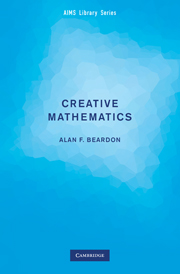6 - Problem B: Solution
Published online by Cambridge University Press: 16 May 2024
Summary
First, you should have noticed that a tower of x is not well defined; for example, 213 could mean 2(13) or (21)3, which are 2 and 8, respectively. This confusion arises because of the common, but careless, way of writing exponentiation without an explicit symbol for the operation. If we mimic a computer language and write a ∧ b for ab, then we have to decide whether a ∧ b ∧ c means a ∧ (b ∧ c) or (a ∧ b) ∧ c. There is an important lesson here: we often have to create, or modify, a definition in order to solve a problem. Here, as (a ∧ b) ∧ c is already defined as abc, we define
Now that we have properly defined repeated exponentiation, we can give a formal definition of the towers of x by induction: let x1 = x, and, for k = 1, 2, … , let xk+1 = xxk . We shall use this notation xk for the towers of x throughout the discussion. For example,
It is easy to see that the towers of x grow very quickly. As 10n has n + 1 digits, it follows that 101010 has 1010 + 1 (ten thousand million and one) digits. Also, 66 = 46656, and if we put 666 = 10n and use logarithms,we see that 666 has more than 36000 digits! It seems unlikely, then, that we can carry out numerical experiments on this problem. These remarks raise the following subsidiary problem.
• Given a, b and c, estimate the number of digits of a(bc)
Next, we make two preliminary observations. First, when x = 1 all towers of x are also 1. This is trivial, but a complete solution must contain a discussion of every case, including the trivial ones. Second, since every tower of x is a power of x, if x is even then every tower of x is even, while if x is odd then every tower of x is odd.
The last digits of the sequence of powers of x may (or may not) be easier to find than the last digits of the towers of x. In any case, as this sequence contains all the information we want, we should consider this sequence too. Indeed, some of our results may hold for this more general sequence..
- Type
- Chapter
- Information
- Creative MathematicsA Gateway to Research, pp. 33 - 36Publisher: Cambridge University PressPrint publication year: 2009



